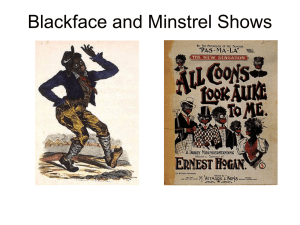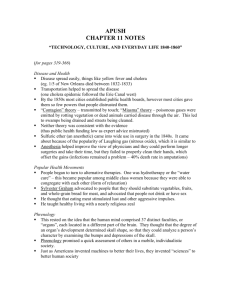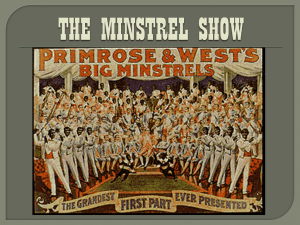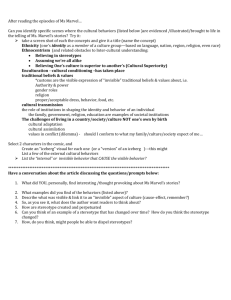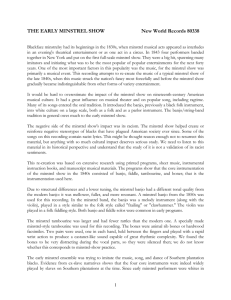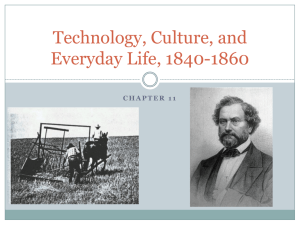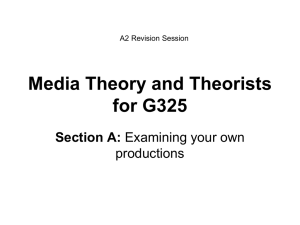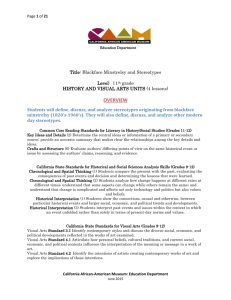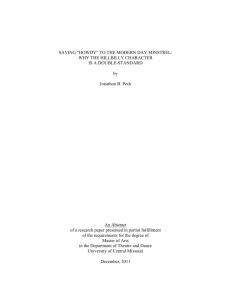Lori…I really like the fact that you did some digging and
advertisement
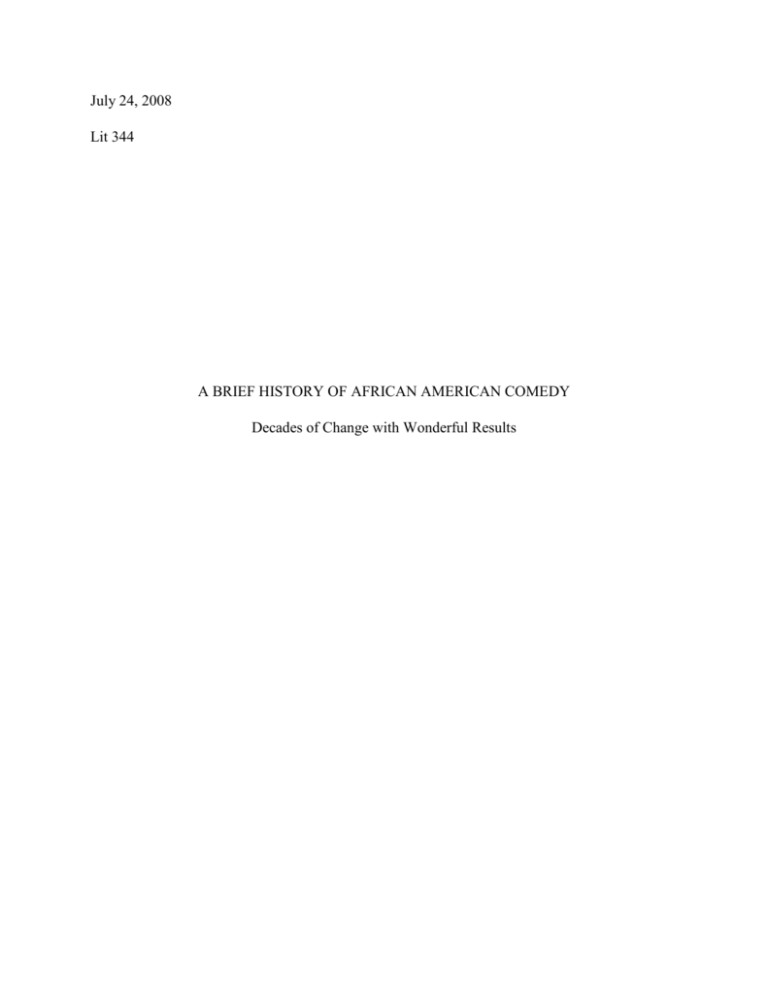
July 24, 2008 Lit 344 A BRIEF HISTORY OF AFRICAN AMERICAN COMEDY Decades of Change with Wonderful Results African-American comedy has changed drastically over the decades. From black minstrels to vaudeville, the black comedian has had only a loose footing in the entertainment industry. Historically, he was expected to play into an absurd stereotype, pandering to white audiences;.however, in doing so the African-American comedian eventually was able to illustrate how absurd the stereotype was and managed to move from a one-dimensional character into a dynamic, satirical, respected and dominating force in today’s comic industry. The African-American comedic stereotype began with the Minstrel Show which “probably evolved from two types of entertainment popular in America before 1830: the impersonation of blacks given by white actors between acts of plays or during circuses; and the performances of black musicians who sang, with banjo accompaniment, in city streets” (minstrel, 1). These shows began sometime in the 1830’s when “a white actor, Thomas Darthmouth Rice, borrowed a song-and-dance routine from a young African American he had seen performing on the street.” Calling himself "Daddy Rice," the actor blackened his face with burnt cork, wore tattered clothing, and performed his "Jump Jim Crow" routine for audiences from New York to London” (plasencia, 1). Instantly popular with white crowds these, “Minstrel shows were completely based on stereotypes of African Americans and their cultures, and had titles such as De Magic Coon, Dark Faces an' Bright Eye-deas, and De Scared Niggers an' De Lost Punch, titles that were supposed to represent the poor English spoken by African-Americans” (plasencia, 1). Minstrel shows "Black Face", 1884 A lone Minstrel entertaining on Eastbourne Sands [Source: http://www.sterlingtimes.org] cashed in on racist attitudes towards African- Americans by 2 centering the show, “ around incompetent characters as dumb as dirt, speaking poor English and lazing around instead of working, [and often placing these] characters [into] mishap[s] due to their stupidity, and the audience would laugh at their inability to survive in reality” (plasencia, 1). By 1850 minstrel shows had “two parts”, the first part was made up of “comic exchange, songs by Tambo and Bones, sentimental ballads by such composers as the American Stephen Foster and a final song by the whole company” (Minstrel, 1). The second part or the “Olio” included “specialty acts, clog dancers, jigs, female impersonations and a burlesque of some serious drama currently popular” (Minstrel, 1). “Later, when the laws were changed to allow African-Americans to perform onstage, the actors in the Minstrel shows were African-Americans, but they too had to perform in blackface” (Plasencia, 1). Often referred to as “blackface minstrelsy” this form of entertainment was most popular “from 1850 to 1870” when “ten theaters in New York City alone were devoted almost solely to such entertainment” (minstrel, 1). The form of entertainment was so popular that you can easily find advertisements for minstrel shows on the Internet from old magazines and newspapers without searching very much (blackface, 1). In fact, this form was so popular that Mark Twain himself has commented that he “loved the form.” In an autobiographical reminiscence dictated in 1906 he said… that, “the genuine nigger show, the extravagant nigger show” was “the show which to me had no peer” and a “thoroughly delightful thing” (blackface, 1). Mark Twain also mentioned minstrel shows in his novels, particularly in Tom Sawyer where “minstrelsy appears in both the text and the illustrations” (blackface, 1). By “1919” however this 3 form of entertainment was in decline perhaps due to economic reasons or due to the “growing craze for gigantic minstrel shows” that were more like vaudeville than minstrel (minstrel, 1). Harmoneons Carolina Minstrels Source: www. musicmasterhour.com Harmoneons Carolina Minstrels, is atypical in its inclusion of a woman, but this picture, from the cover of a piece of sheet music published in 1845, is the earliest illustration of minstrelsy in the Barrett Collection (blackface, 1). While minstrel shows were not all about comedy, they included comedy in part and the entire minstrel show was based upon American’s desire to laugh at the African-American stereotype. Minstrel shows can be credited with getting black comedians on stage, a place where they were not allowed before, and with opening doors for future black comedians to take their place in the spotlight. Performers like Bert Williams brought minstrel to vaudeville, usually traveling with all white casts, and making their marks among the white performers and white audiences. In Bert’s case his white cast-mates often complained about Bert Williams being billed with him because they were [Source: www.pbs.org] 4 offended that his material (which he wrote himself) was better than theirs (Bert, 1). His performances were extremely popular and, “1918 Williams broke another color line when he topped the bill at New York City's Palace” (Bert, 1). Overall his presence in vaudeville promoted the black stereotype while simultaneously serving to illustrate how absurd the stereotype itself was. Stephen Rosenfield, founder and director of the American comedy Institute in New York City points out that comedian have the power to change stereotypes (Cohen/Richards,1). He notes that, “by talking about themselves with a sense of humor, they begin to recognize how dimensional the stereotyped group is...“If they know how to make us laugh, there’s a connection, a cultural cross-over. The original stereotype will start breaking down, making it harder to perpetuate” (Cohen/Richards, 2). By becoming so successful and popular, Bert Williams was accepted by a mostly white audience. He changed attitudes by allowing the audience to see how foolish the black stereotype was; for how could a simple “Jim Crow” become so successful, be so witty, so clever, so talented? Another comedian who used the black stereotype to her advantage was Jackie “Moms” Mabley, popular from “1939 into the 60’s” (Ankeny, 1). She capitalized on the frumpy, unkempt, uneducated black stereotype by dressing on stage in oversized hats and billowing house dresses; however she also shocked audiences with her frank, smart humor and sexually suggestive material. Dr. Cynthia Merriwether-de Vries, a sociology professor at Juniata College who Jackie “Moms” Mabley Source: www.britannica.com specializes in humor, music and popular culture says of Mabley 5 “[s]he made fun of old black women and domestics, never wore a bra, accentuated her droopiness, and made fun of the fact that she had no teeth… In short, she played upon the stereotypes of what was wrong with black women” [and suggests that by doing so] Mabley was taking ownerships over the stereotypes (Cohen/Richards, 2). Entertainers like Williams and Mabley were able to demonstrate how absurd the stereotype was, and in doing so “undermined the potency of [such] prejudices” , here they opened the doors for the next waves of comedians whose work slowly changed the stereotype itself (Cohen/Richards, 2). Comedians like Nipsey Russell, Dick Gregory, Godfrey Cambridge, and Bill Cosby challenged the stereotype by wearing professional clothing, playing to mainstream audiences, and by demonstrating their education and speaking abilities in their comic work. Nipsey Russell Source:thedryspot.wordpress.com Dick Gregory Source:www.harvardsquarelibrary.org 6 Godfrey Cambridge Bill Cosby Source: www.aaregistry.com Source: www.bsu.edu Russell’s work “was hip, glib and conspicuously intelligent, he attracted downtown crowds to Harlem, becoming a standout pull at the Baby Grand, Small's Paradise and other cabarets with puns like ‘America is the only place in the world where you can work in an Arab home in a Scandinavian neighborhood and find a Puerto Rican baby eating matzo balls with chopsticks’”(Russell, 1). Gregory’s bits, on the other hand, were “detached, ironic, and satirical” and were often two liners like this: "Segregation is not all bad. Have you ever heard of a collision where the people in the back of the bus got hurt?"(Myles, 2). Gregory challenged the stereotype even further than his comedic peers by becoming well known for his activism, both in political, humanitarian, and Civil right arenas; in fact he is more well-known for these acts than his comedic ones (Myles, 2). These comedians reshaped the African-American comedy by allowing it to become intellectual, mainstream, and political. The comedians moved black comedy out of the minstrel, Aunt Jemiamah or Jim Crow realms and into a place where African-American comedians could be more than just a one-dimensional stereotypical stage act. African-American comedians today are pushing the limits even further. From minstrel to vaudeville to television and movies, today’s black comedians’ can shock, teach, and tease you into laughter. While entertainers like 7 Cosby and Cambridge removed stereotypical Jim-Crow-type-humor from their acts, modern entertainers like Dave Chapelle and Chris Rock can make us laugh by embracing, defacing, and playing on the stereotype (both modern and historical) and still make points about political, social, and cultural issues. 8 Works Cited Ankeny, Jason. “Moms Mabley”. All Music. Com. As found on the Internet, July 28, 2008 at: http://www.allmusic.com/cg/amg.dll?p=amg&sql=11:hifexq9gldke~T1. “Bert Williams”. Broadway the American Musical Online. Thirteen/WNET New York. Educational Broadcasting Corporation. Last modified 2004. As found on the internet at: http://www.pbs.org/wnet/broadway/stars/williams_b.html. “Blackface Minstrelsy”. As found on the Internet on July 25, 2008 at: http://etext.lib.virginia.edu/railton/huckfinn/minstrl.html. Cohen, Roger & Richards, Ryan. “What’s Taboo? When the truth hurst, tell a joke: why America needs its comedians. Humanity in Action. USA 2006. As found on Blackboard, Lit 344 forum at: https://blackboard.snhu.edu/webapps/portal/frameset.jsp?tab_id=_2_1&url=%2fwe bapps%2fblackboard%2fexecute%2flauncher%3ftype%3dCourse%26id%3d_219_1 %26url%3d. “Minstrel History”. Sterling Times.org. As found on the Internet on July 27, 2008 at: http://www.sterlingtimes.org/memorable_images29.htm. Myles, Theodore. “Dick Gregory for the people…activist, philosopher, anti-drug crusader, comedian, author, actor, recording artist, nutritionist”. Theodore Myles Publishing, Inc. As found on the Internet, July 27, 2008 @ http://www.dickgregory.com/about_dick_gregory.html. “Nipsey Russell”. The African American Registry. As found on the Internet, July 27,2008 at: http://www.aaregistry.com/detail.php?id=2801. Plasencia, Alia. “The Legacy of Racism in American Media”. Fertile Field. February 2003. As found on the Internet on July 26, 2008 at: http://www.fertilefield.org/articles/archives/000014.html. 9
